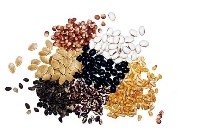
What is a hybrid seed and what is an heirloom seed and why it matters
The official scientific definition of a hybrid is the “offspring resulting from the interbreeding between two animals or plants of different taxa.”
Okay, yeah. That’s great if you’re part of the cast of “Big Bang Theory“. I know, I know — now how about in English, right? What is a hybrid seed in language the rest of us can understand? I’m glad you asked!
And while I’m at it, I’ll even answer the next question: why should you care?
The history of hybrid seeds
The first hybrid plants were corn plants developed by Henry Wallace in the 1920’s. Wallace, who would go on to become Vice President of the U.S. under Franklin D. Roosevelt, was convinced that modifying the corn crops could reduce costs and allow people access to lower-priced food.
The work was based on the discoveries of Gregor Mendel, as a part of his landmark experiments in genetics.
Wallace’s initial work required people to remove certain plant parts to force pollination by a chosen, different type of corn. The result was a predictably standardized corn that he believed would contain the best of both types.
~
Experiments in hybridization moved into rice, and then spread to other food crops such as hybrid tomatoes, peppers and fruit trees. Some hybrids were effective in reducing disease or increasing growth. But others spelled disasters as uniform crops were sometimes wiped out by a single fungus or insect (in a diverse crop, some would usually survive due to genetic diversity.)
Types of hybrid crosses
Hybrid seeds are not always the result of a single cross between two types of a plant. Hybrids can also be doubles, which means that two already hybrid crops are crossed. Some are even triple hybrids, with more layers of hybrid plants introduced to create seeds that combine the characteristics of six or more simple plant varieties.
Recent hybridization projects have even allowed botanists to test crosses among different types of food, mixing characteristics of fruits with those of vegetables, or even animals in an effort to improve yield or shelf life. This kind of tinkering with food products has raised alarm among some health specialists who are concerned about the long-term effects of genetically altered food.
What hybrids do best
Planting hybrids allows farmers to know exactly what to expect from a crop in terms of water needs, disease susceptibility, nutritional needs and expected yield. That means they can spend less time watching crops, and can successfully manage more plants in a single growing season.
Many hybrids have also been “designed” to better withstand the stresses of early harvesting, long distance transportation and longer times on grocery store shelves. Those changes allow us to enjoy peaches in February and oranges in mid-July, even though the local season was months away…or doesn’t even exist in a certain location (think grapefruit in North Dakota….hardly a local crop!)
Hybrids are also popular with home gardeners who want to know exactly what kind of vegetable or fruit they can expect from the seeds they plant.
What hybrids can’t do
A hybrid seed typically produces a single generation of plants and fruit or root crops. Although the plants or fruit that grow do include seeds, the seeds do not carry the characteristics of the parent seed.
Planting these second generation seeds can result in a mixed-bag of qualities, sometimes missing the desired traits. Or the seeds may be sterile — they appear to be normal seeds, but fail to germinate when planted.
The problems with hybrids
I’ve already alluded to a couple of the major issues with hybrid seeds. The first is the uniformity, which can quickly turn from a benefit to a liability if a disease or bug targets that specific seed’s characteristics. The second is the inability to build seed reserves from existing crop harvests — hybrid seeds need to be purchased new for each planting season.
Another issue that arises is that the selection of some traits valued by farmers and distributors (such as the ability to remain fresh during transport) may be at the expense of other traits valued by consumers (like taste or nutrition.) Anyone who has tasted a fresh-from-the-garden tomato or just-picked peaches versus a standard grocery store version can attest to the vast difference in the experience, especially when the garden one was an heirloom (non-hybrid) plant.
The heirloom seed push-back
People concerned about the weaknesses in hybrid plants (especially food plants) as well as unknown health risks have led the charge to save and share heirloom or non-hybrid seeds.
Seed banks have sprung up around the world, and companies who deal in only pure heirloom seed lines have thrived as people seek the taste and variety of older produce strains.

